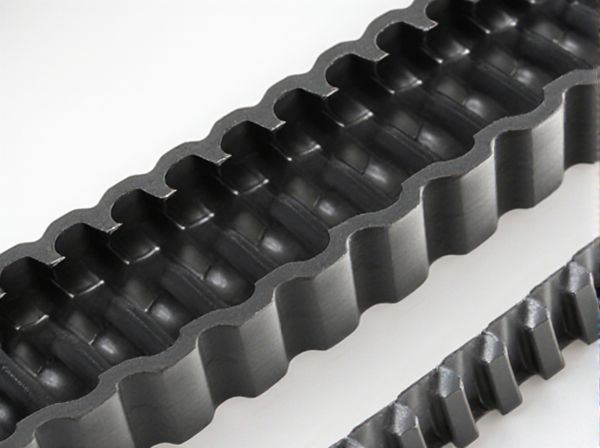
Photo illustration: Square Tooth Profile vs Curvilinear Tooth Profile
Square tooth profiles feature straight edges and sharp corners, providing increased load-bearing capacity and easier manufacturing but may cause higher stress concentrations. Curvilinear tooth profiles offer smoother transitions and reduced stress concentrations, enhancing fatigue strength and performance under dynamic loads. Your choice depends on application requirements, balancing ease of production with durability and noise reduction.
Table of Comparison
| Feature | Square Tooth Profile | Curvilinear Tooth Profile |
|---|---|---|
| Tooth Shape | Sharp, rectangular edges | Smooth, rounded edges |
| Load Distribution | Concentrated stress on tooth edges | Evenly spread stress across tooth surface |
| Noise Level | Higher noise due to impact contact | Lower noise with smooth meshing |
| Wear Resistance | Prone to faster wear and tear | Enhanced durability and longevity |
| Efficiency | Less efficient power transmission | Improved power transfer efficiency |
| Application | Older or basic timing belt designs | Modern, high-performance timing belts |
Introduction to Gear Tooth Profiles
Square tooth profiles feature straight, angular edges providing simplicity in manufacturing and ease of alignment, but often result in higher stress concentrations and increased noise during operation. Curvilinear tooth profiles utilize smooth, curved shapes that enhance load distribution, reduce vibration, and improve gear efficiency and longevity. Selecting the appropriate gear tooth profile depends on factors such as load capacity, precision requirements, and noise reduction needs in mechanical systems.
Overview of Square Tooth Profile
The Square Tooth Profile features straight, sharp edges and flat surfaces, providing high load capacity and ease of manufacturing. This profile generates more noise and stress concentration compared to curvilinear profiles, which limits its use in high-speed or high-precision applications. It is commonly employed in heavy-duty machinery where strength and durability outweigh smooth operation.
Overview of Curvilinear Tooth Profile
Curvilinear tooth profiles feature a smooth, curved shape designed to reduce noise and vibration during gear operation, enhancing efficiency and durability. These profiles allow for more gradual engagement between gear teeth, distributing load more evenly compared to square tooth profiles. Commonly used in precision machinery, curvilinear designs improve performance by minimizing stress concentrations and wear.
Structural Differences: Square vs Curvilinear
Square tooth profiles feature sharp, angular edges providing straightforward load transfer but generate higher stress concentrations at the corners, potentially reducing fatigue life. Curvilinear tooth profiles incorporate smoothly curved surfaces that distribute stress more evenly along the tooth engagement, enhancing durability and reducing noise. The structural difference lies in the geometry that influences mechanical performance, with square profiles emphasizing simplicity and curvilinear ones optimizing stress distribution.
Load Distribution and Efficiency
Square tooth profiles provide straightforward load distribution with concentrated stress points, often resulting in increased wear and noise under heavy loads. Curvilinear tooth profiles optimize load distribution by allowing gradual contact engagement, reducing stress concentrations and enhancing overall gear efficiency. This smoother meshing action improves power transmission and prolongs gear lifespan in high-performance applications.
Wear Resistance and Durability
Square tooth profiles exhibit higher initial wear resistance due to their uniform load distribution, making them suitable for heavy-duty applications. Curvilinear tooth profiles enhance durability by reducing stress concentrations and promoting smoother engagement, leading to decreased fatigue and extended service life. Optimizing tooth geometry based on operating conditions ensures improved performance and longevity in mechanical gear systems.
Manufacturing Challenges and Costs
Square tooth profiles in gears present manufacturing challenges due to the need for precise, sharp corners that require more complex machining processes and increased tool wear, driving up production costs. Curvilinear tooth profiles, with their smooth contours, enable easier and faster manufacturing using standard cutting tools, reducing both machining time and expenses. Despite higher initial costs, square profiles may offer benefits in load distribution but demand more stringent quality control to ensure durability and performance.
Application Suitability and Industries
Square tooth profiles are ideal for heavy-duty applications requiring high load capacity and precise indexing, commonly used in machine tools, manufacturing equipment, and robotics. Curvilinear tooth profiles excel in high-speed, smooth operation with reduced vibration, making them suitable for automotive transmissions, aerospace gearboxes, and precision instruments. Industries such as automotive and aerospace favor curvilinear profiles for noise reduction and efficiency, while industrial machinery and heavy equipment rely on square profiles for durability and strength.
Performance Comparison: Noise and Vibration
Square tooth profiles generally produce higher noise and vibration levels due to abrupt load transitions and stress concentrations at the tooth edges. Curvilinear tooth profiles, designed with gradual load transfer and smooth contact lines, significantly reduce vibration and noise by minimizing impact forces and ensuring continuous engagement. Studies indicate curvilinear teeth improve gear mesh dynamics, resulting in quieter and smoother transmission performance.
Choosing the Right Tooth Profile for Your Needs
Square tooth profiles offer increased strength and durability, making them ideal for heavy-load applications in industrial machinery. Curvilinear tooth profiles provide smoother engagement and reduced noise, which is beneficial for high-speed or precision gearing systems. Selecting the right tooth profile depends on whether your priority is robustness under stress or operational smoothness and efficiency.
 caratoz.com
caratoz.com